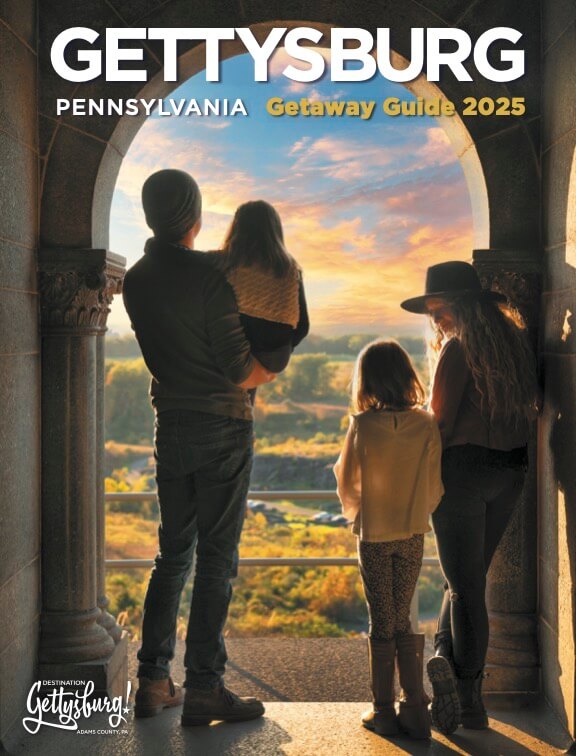Get the 2025 Gettysburg Getaway Guide
Check out our Getaway Guide online or have us send you one. Have an immediate question? Call us at 1.800.337.5015
Get the GuideThe Gettysburg Battlefield spans nearly 6,000 acres. From monuments and wayside markers to distinctive boulders and undulating ridges, there is a lot to see and learn while exploring the battlefield.
Countless locations on the battlefield provide vantage points that not only offer valuable insight into the military positions of both the Union and Confederate armies, but also showcase incredible vistas of this historic and hallowed land.
Join us as we discover some of the best vantage points on the Gettysburg Battlefield.
You are currently standing in the Cupola atop the former Lutheran Theological Seminary. In 1863, this was one of the tallest man-made buildings in Gettysburg. Standing 70 feet off Seminary Ridge, the views from the Cupola offer a 360-degree perspective on how the Battle of Gettysburg materialized and took shape.
On the early morning of July 1, 1863, the Battle of Gettysburg erupted in the fields northwest of town. From this Cupola, Union officers located columns of Confederate infantry approaching Gettysburg via the Chambersburg Pike. The only Union forces present in the area were General John Buford’s cavalry.
Buford recognized strong defensive positions south of town (Culp’s Hill, Cemetery Hill, Cemetery Ridge) and knew if Confederates controlled the road network in town, it would allow them easy access to this vital high ground.
Outnumbered, Buford devised a strategy in utilizing the distant ridges as defensive positions to buy time for Union reinforcements. Buford placed his dismounted cavalry on Herr’s Ridge, then McPherson Ridge, and finally Seminary Ridge.
Although the Union were ultimately forced to retreat, they fell back to the high ground that proved integral to the outcome of battle.
Interested in checking out the Cupola yourself? Take a tour at the Seminary Ridge Museum and venture up to the Cupola for these magnificent views.
Benner’s Hill is one of the least visited locations on the Gettysburg Battlefield. Located off Hanover Road, Confederate forces used this rise of land as an artillery platform and a staging area for their assault on Culp’s Hill. From this vantage point, you can make out Culp’s Hill, Cemetery Hill, the town of Gettysburg, and Oak Ridge.
By July 2, 1863, the Union Army controlled Culp’s Hill and Cemetery Hill, located 1,000 and 1,500 yards away respectively. At around 4 p.m., Confederate artillery under Major Joseph W. Latimer opened fire on Cemetery Hill from Benner’s Hill.
The Confederate’s position was located on a long, narrow ridge that was lower in elevation to the opposing Union positions. This proved disastrous as the Confederates received devastating fire from Culp’s Hill, Stevens’ Knoll, and Cemetery Hill.
This resulted in an unequal contest. Caissons exploded, guns were disabled, and Latimer was mortally wounded. The Confederate position was decimated, and they were forced to withdraw.
During the Battle of Gettysburg, Culp’s Hill was the right flank of the Union Army. Culp’s Hill protected the Baltimore Pike, which was an important route that supplied the Union with food and ammunition and provided a direct pathway to Baltimore and Washington, D.C. It was therefore imperative for the Union to hold the hill.
The Confederates attacked Culp’s Hill on July 2 and 3, 1863, but were repulsed each time. Union Brigade General George S. Greene’s background in civil engineering came in handy as he ordered his troops to fell trees and collect rocks and earth to create strong, defensive positions. These formidable breastworks made attacking the hill even more difficult.
The vantage point from Powers Hill offers a clear sightline to Spangler’s Spring and Culp’s Hill. During the Battle of Gettysburg, this hill was an important military position for Union artillery.
By July 3, 1863, Confederate forces gained control of Union breastworks on lower Culp’s Hill. To drive the Confederates back and retake the works, Union artillery fired upon Southern forces from Powers Hill.
This proved successful, as the Confederates found it difficult to advance farther up the hill as cannon rained on them. Union artillery atop this hill ultimately played an important role in securing the right flank of the Union army.
Imagine watching 12,500 Confederate soldiers emerging from the distant wood line along Seminary Ridge. This is exactly what happened on July 3, 1863. By the third day of battle, the Confederates had attacked the Union left and right flanks. Confederate General Robert E. Lee decided to mount a frontal assault toward the center of Union lines on Cemetery Ridge.
Starting at 1 p.m., Confederate artillery on Seminary Ridge bombarded the Union position on Cemetery Ridge for nearly two hours, inflicting minimal damage. At around 3 p.m., over 12,000 Confederate soldiers stepped forward into this open field while receiving horrific artillery fire from the Federals.
For nearly three-quarters of a mile, Confederate soldiers marched toward the Emmitsburg Road. They climbed the fence of this sunken road and continued forward. As the few remaining Confederate soldiers reached the Union line, Federal reinforcements put an end to any hope of victory for the Confederates.
The Union position did not break, and the Confederates were forced to retreat back to Virginia. The Battle of Gettysburg was over.

Check out our Getaway Guide online or have us send you one. Have an immediate question? Call us at 1.800.337.5015
Get the GuideDon’t miss a thing that’s going on in Gettysburg; sign up to receive our fun and informative travel planning newsletter.
Let's Go